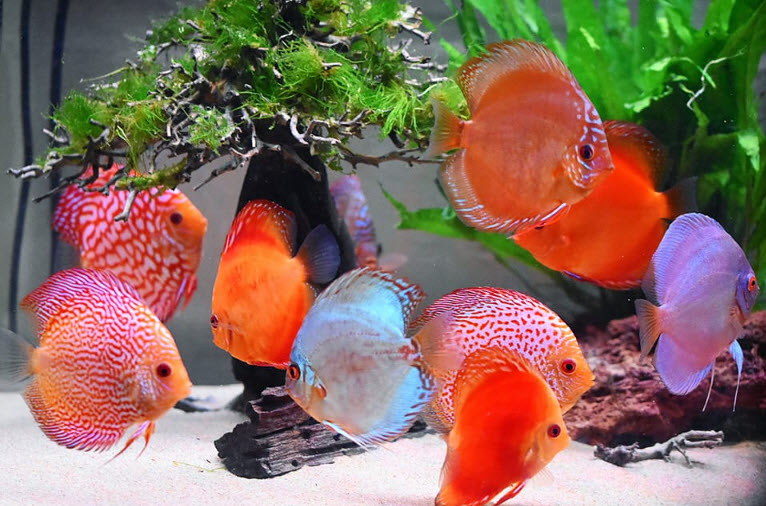
I found the key to decorative discus is ultra-crystal-clear water with NO bacteria counts and a HUGE amount of biofiltration. And I mean HUGE! For decorative discus one should ideally have a sump of at least 40% of the aquarium size (a 50 gallon aquarium needs at least a 20 gallon sump). This sump should ideally be filled with one of four arrangements:
- a fluidized bed of K1 type media,
- layer after layer of 20 ppI to 30 ppi Poret Foam
- brightly colored plastic pot scrubbers
- Stationary K1 type media
With decorative discus that is the ONLY filtration method I can recommend. But note many are successful with other methods. These are not “rules”. For instance all my discus tanks also have under-gravel filters in addition to large fluidized bed sumps.
The key for discus is to look down the length of the tank, through four or six feet of water. Are the ornaments and fish four feet away crystal clear and do they look like they are flying in air? Or is everything kind of “dull” and unclear? If it is “dull” there can be a problem. This clear water typically can only be found in over filtered aquariums whose filters have been in operation for more than four months.
The aquarium below has a slight haze to the water. Hopefully this is because the substrate was just disturbed by a water change. If that haze is “normal” these discus are probably going to have some health problems.
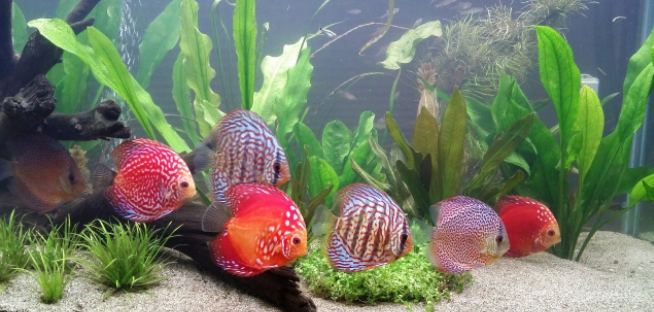
Bacteria free, crystal-clear water is obtained by several factors:
- Over-filtration. Using a very good high surface area filter media in a large filter (preferably foam, K1 or pot scrubbers in a large sump, or a K1 fluidized bed sump, and definitely not a hang-on-back filter) that gives well over 100 square feet of surface area for every pound of fish. Note we only recommend a 2X turn-over through this sump (i.e., a 100 gallon tank with a 30 gallon sump that has only a flow of 260 gallons per hour, or ([100+30] x 2).
- Having a filter which has been established and uncleaned for at least four months. This gets the build-up of beneficial brown gunk to the point where it can be effective.
- Adding a UV Unit which is on 24/7. A UV unit will prevent bad bacteria from reproducing somewhat. But UV doesn’t remove dissolved organic compounds (DOCs) like biofiltration will. So UV should only be an adjunct to very good biofiltration.
- Excellent aeration. Since discus like still water this can present a challenge. I do this aeration in the sump.
Obviously a program which combines any and all of these processes will give the greatest probability of success.
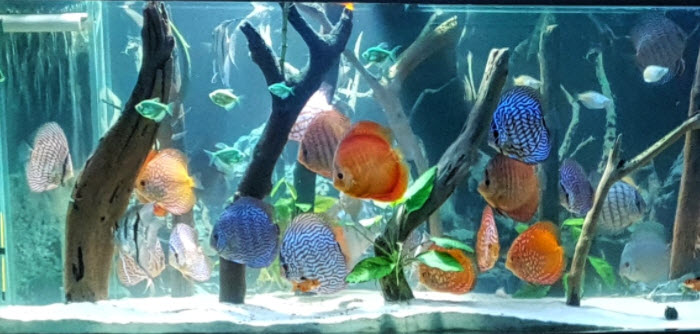
It is important to note that 100 square feet of surface area per pound of fish is just one of four methods that can produce SOMEWHAT clear water. All four methods are:
- 100 square feet of filter media surface area per pound of fish
- A polishing filter media such as Polyfil (polyester fibers), polyester mats (Pinkie Pads) or 40 ppi foam (i.e. “mechanical filtration”).
- A UV setup left on 24/7 kills the bacteria and infusoria in the water column.
- 50% to 100% water changes every day
What is important here is the difference between “somewhat” clear and “crystal” clear. “Somewhat” clear isn’t bacteria free water. It is water where the large visible particles have been filtered out but the microscopic stuff remains. Packed polyester (Polyfil) will filter out 200 micron particles. Most infusoria will be less than 200 microns and bacteria are 2 to 8 microns in size. This “somewhat” clear water can be very unhealthy water.
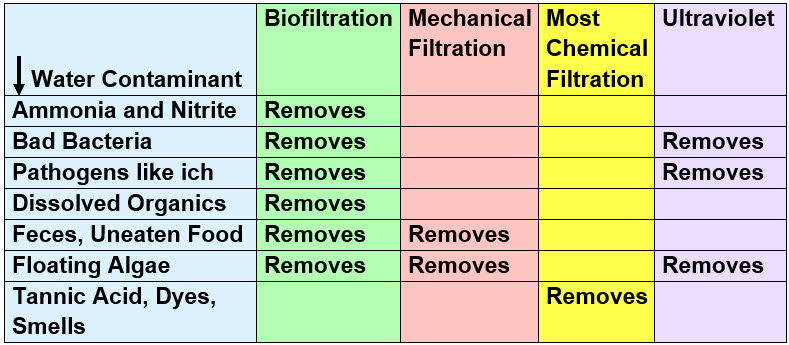
Using 100 square foot of filter media surface area per pound of fish will produce much clearer water than the other three methods as filtration by lots of surface area and flow will eliminate something called “DOCs”, or dissolved organic compounds. Dissolved organic compounds come from food and feces and are what bacteria feed on. Polishing filter media and UV don’t eliminate DOCs so they don’t produce as clear of water. Large scale water changes only eliminate a portion of the dissolved organic compounds as feces and decaying food are producing DOCs 24/7.
To calculate the size of the filter needed for discus one needs to do some math.
For more on how to calculate filter volume go to these articles:
8.8. Filter and Media Design
8.8.1. Sizing Filters in Depth
7.3. Media Volume
7.6. Required Aquarium Filter Media Surface Area
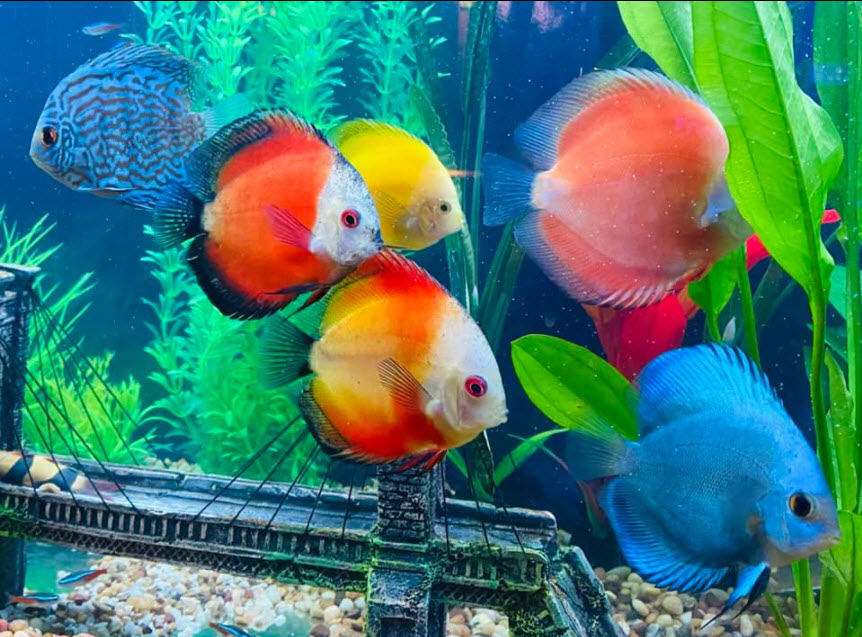
Information on Discus
The following articles will be useful reading if you are contemplating keeping discus:
17.11. Discus
17.11.1. Discus Husbandry
17.11.3. Water for Discus
17.11.4. Food for Discus
17.11.5. Discus Pheromones
17.11.6. Breeding Discus
17.11.7. Discus Aquarium Photos
.
Return to Fish Selection Menu
.
Aquarium Science Website
The chapters shown below or on the right side in maroon lead to close to 400 articles on all aspects of keeping a freshwater aquarium. These articles have NO links to profit making sites and are thus unbiased in their recommendations, unlike all the for-profit sites you will find with Google. Bookmark and browse!
.

Dave says
In reply to Gabriel ….. It will work just fine IF and ONLY IF the Eheim media is switched out to foam (30 or 20 ppi), pot scrubbers or stationary K1 type media. The advertised surface area for the Eheim media is bullshit.
http://aquariumscience.org/index.php/7-3-media-volume/ Water changes will depend on feeding and plants, not the filter or filter media.
Gabriel says
Hi Dave,
Grateful if you can advise: would below European setup assure clear water for one tank of decorative discus, with very rare water changes?
Tank: 115 gal with 6 discus and 20 other smaller species below 3 inches. Filters – 2 canisters Eheim professionel 3, as follows:
– 2 x 0.4 gal pre filter + 2 x 3.2 gal of biological filter.
– 2 x 25 Watts power heads
– Biological filtering: Eheim substrate, 450 sq. meters per liter (18000 Sq feet per gal).
– Overall, the total advertised surface of biological media would be: 2 filters x 3.2 gal x 18000 Sq feet per gal = 115200 sq. feet.
– UV filters: 2 x 9 Watts.
Thanks and all the best,
Gabriel
Dave says
IN reply to Brad … Nitrogen is being removed from the system in two ways: 1, The zeolite is removing it as ammonia and 2, plant trimmings are removing the nitrogen as nitrate
Brad says
Hi Dave,
We saw this on YouTube (Discuss with no water change for 10+ years) and I could not reconcile what was going on. There seems to be heavy maintenance (with a gravel filter through a 1 micron pump?!) but insists the water is never changed. I read your site to try and understand how this could be achieved, but I could not understand the methods that would have to be used to achieve!
https://youtu.be/d2HCb9-H7y8
What do you think about this? i.e. if this is true, do the methods actually work or is something else at hand going on?
Thanks
Brad
Dave says
Jimmy …. Rams are just like discus in that they require bacteria free water. Like discus, they are NOT sensitive to nitrates. Lots of planted tank enthusiasts keep and breed rams at 50 ppm nitrate.
Jimmy says
What are your thoughts on keeping German blue rams? Would you say that keeping blue rams is pretty similar to keeping discus in terms of needing bacteria-free water? Everywhere I search, it seems that blue ram keepers say that low nitrate is really important.
Dave says
In reply to Jack …. Angelfish are more forgiving. But they will do very well under all the conditions outlined for discus.
Jack says
Hi Dave, thanks for all the detailed information on Discus, to what extent could this information be applied to angelfish? They appear very similar in look’s and origin as South American cichlids. Are angelfish any more ‘forgiving’?
Dave says
In reply to Victor …. Discus can get to be pretty big fish. And they like to be in groups of at least six. Six large fish would be pushing the capability of an undergravel in a 65 gallon. So I would recommend adding something along the lines of a Sunsun 304B with pot scrubbers to the tank. Of course you can always start out with just a undergravel with the option of adding a canister if the water doesn’t go crystal clear after three or four months.
Victor says
Mr. David:
Hello. First of all we would like to thank you for taking your time on building this website and working so hard on your invaluable articles just for us to have access to all of this information. It has been an amazing, eye-opening trip my wife and I have enjoyed.
We have been planning on building a discus aquarium of 65 gallons.
We only plan on having small driftwood pieces, medium rocks and some anubias. For tank mates, some rummy nose, cardinal tetra and some corydoras.
We were wondering:
1. Is it possible to have the tank set up with just undergravel filtration?
2. If so, what what would be the best way to arrange it?
3. How many discus would you recommend in this setup?
We would greatly appreciate your opinion.